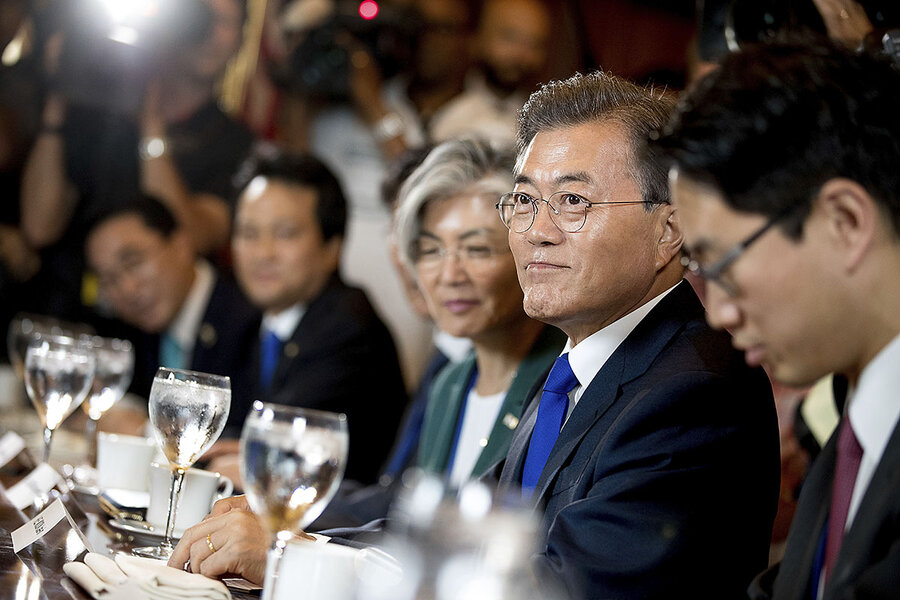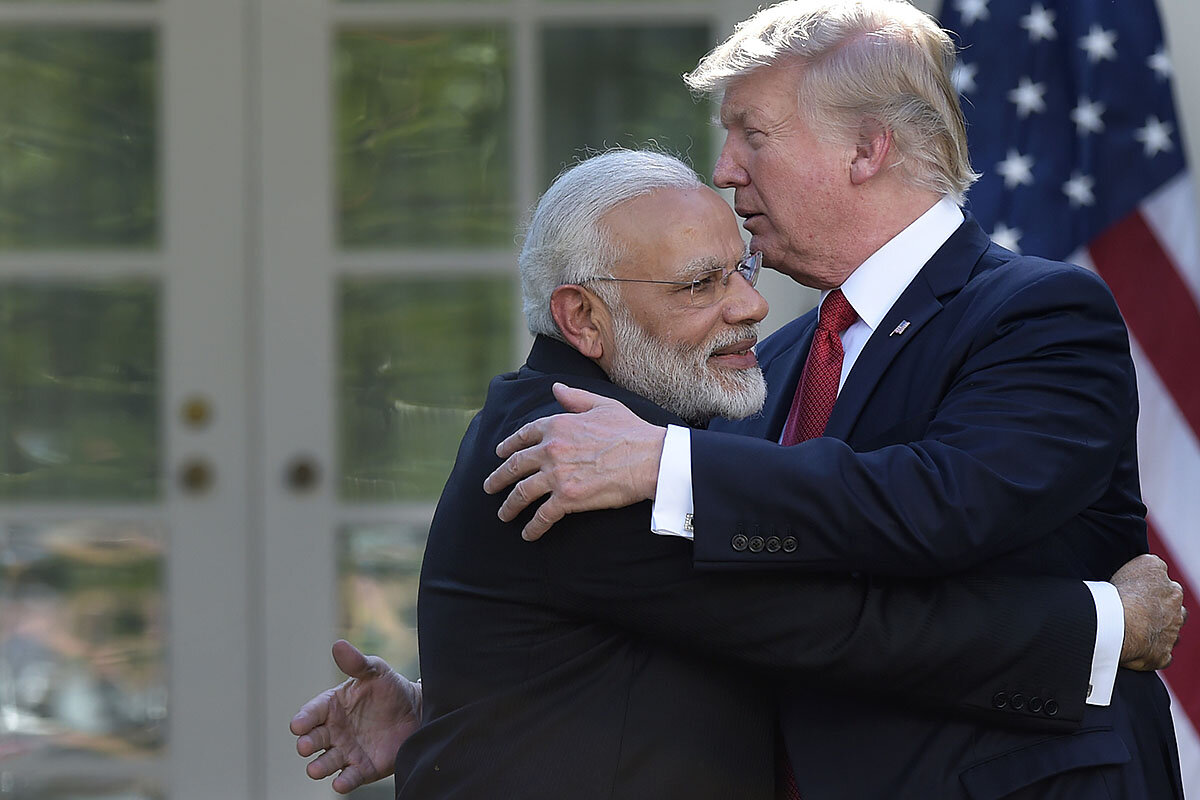To confront a rising China, what is Trump offering Asian allies?
Loading...
| Washington
Obamacare is not the only one of his predecessor’s policies that President Trump is seeking to undo.
Consider the Asia “pivot.”
Mr. Trump has taken a number of steps that gut the core of former President Barack Obama’s strategy for adding economic and security muscle to America’s role in the Asia-Pacific region.
The Trans-Pacific Partnership, the 12-nation trade pact led by the United States that was the economic backbone of the “pivot?” Out.
Security partnerships have been rattled, with allies like South Korea and Japan being told they need to pay more for the security blanket that the US has been providing in the era of a rising China.
Moreover, the attempt to tether Asia more closely to the US-led international system of rules-based agreements and institutions has been undercut by the US withdrawal from the Paris Climate Accord – an agreement with particularly strong relevance for developing Asian economies – ironically ceding US leadership to China.
“On Asia policy, Obama had his pivot – and Trump has his retreat,” says Karl Inderfurth, a former assistant secretary of State for South Asian affairs in the Clinton administration. “It’s a retreat from economic and regional leadership that has not gone unanswered, but which has already benefited the Chinese.”
This week, with bookend visits to the White House by two key Asian leaders – India’s Prime Minister Narendra Modi was there Monday, while South Korea’s newly elected President Moon Jae-in is scheduled there Thursday evening and Friday – the question arises: What replaces the Asia pivot?
Incomplete Asia teams in both the White House and State Department would make it difficult to formulate a comprehensive strategy even if the president had one in mind, many analysts point out. Yet the answer remains: The Trump administration has articulated no Asia strategy.
Analysts say the Trump policy is likely to be based more on bilateral relationships, an approach the president prefers over multilateral engagement. The Modi and Moon White House visits are just the most recent in a string of one-on-one meetings with Asian leaders, they point out.
Beyond that, Asia experts say there is rising evidence that the chief beneficiary of the current policy muddle is China – whose growing economic heft and regional aggressiveness the Asia pivot was designed in part to restrain.
And as China wins more broadly across Asia, these experts say, the loser will likely be not just American economic and security interests, but the values of democratic governance, human rights, and the rules-based international order the US has long sought to spread and deepen across Asia.
For allies, unanswered questions
“The Trump team does not yet have an Asia strategy. They’ve done a lot of piecemeal deconstruction, but have not yet come up with anything to replace the template handed off to them by the Obama administration,” says Charles Kupchan, a senior fellow at the Council on Foreign Relations in Washington who served on the National Security Council in the Obama White House.
That combination of “deconstructing” one Asia policy before formulating a new one has confused US allies in the region and left many unanswered questions – even as it has paved the way for China’s regional and indeed global ambitions, some say.
The Modi and Moon visits this week highlight the unsettling impact Trump’s lack of an Asia policy is having across the region.
Mr. Modi came looking for signs the US will continue to fortify its strategic relationship with India in the face of what some see as an increasingly hegemonic China. And indeed, some Trump aides were happy to let it filter out that the president intended Modi’s White House visit in part to send a message to China.
That was especially true, they added, after the president’s “disappointment” that China had not delivered on cutting the financial flows propping up the regime of Kim Jong-un in North Korea and funding the North’s nuclear weapons program.
The two leaders discussed trade, but one of the more high-profile moments of Modi’s US visit was his meeting with the chief executives of more than 20 top technology and social media companies. Essentially Modi offered a sales pitch to invest and create jobs in India to the same companies Trump is pressing to get with the “America First” program and return jobs to the US.
Another hug for Trump?
For some, the awkwardness of trying to advance relations with a US administration that is dominated more by presidential personality than by presidential policy was captured in a hug the Indian prime minister attempted to give Trump.
“That attempt at a hug said so much, it demonstrated how these leaders are trying everything they can to figure out how to deal with Trump and get on his good side,” says Inderfurth, who is now an adjunct professor in South Asian affairs at the Johns Hopkins School of Advanced International Studies in Washington.
“I don’t think President Moon will attempt a hug, but we know the Koreans have been studying what works with this president,” he says.
South Korean officials say Mr. Moon and his aides have paid close attention to Trump’s meetings with Chinese President Xi Jinping and Japanese Prime Minister Shinzō Abe, two foreign leaders’ encounters with the new American president widely considered to have been successes.
That has led South Korean officials to believe Moon can hit it off with Trump despite differences over North Korea and trade policies. And White House officials appear to confirm that hunch.
At a press briefing Wednesday on Moon’s visit, a senior White House official downplayed differences between the two leaders. On North Korea, the official noted that both Trump and Moon have talked about diplomatic engagement with Pyongyang once the North has significantly reduced the threat posed by its missiles and nuclear weapons – but increasing pressure on the North through sanctions and other means until then.
“That’s President Moon’s approach, and that’s President Trump’s approach,” the official said. He also said he anticipated a “friendly, frank discussion” with Moon concerning South Korea’s trade imbalance with the US.
Centrality of trade
For some foreign policy analysts, the trade issue stands at the center of why the Trump administration has yet to develop an Asia policy.
“We have to remember that in the minds of Trump’s electoral base, it’s Asia that represents the real challenge when it comes to jobs and America’s prosperity,” says Dr. Kupchan of the Council on Foreign Relations. “In the public imagination, it’s China, India, South Korea, and countries of Southeast Asia that have been responsible for the off-shoring of American jobs.”
Obama’s response to that was to try to “burrow in” to the Asian economies to reap benefits for the American economy, he says. Trump’s very different approach “is to use protectionism to restore American jobs,” Kupchan adds, “but what that means for America’s role in Asia remains very blurry.”
Yet while the impact of a broad retreat from Asia may be unclear, Kupchan says he senses that a significant shift could come in where many Asian countries turn for leadership and guidance.
“Nations realize that we are in the midst of a historic shift in the global balance of power, they are watching to see who has the upper hand in the contest between the US and China,” he says, “and they will adjust their plans and turn their gaze accordingly.”
In such a big-power contest, Kupchan says the “key question” ultimately will be which country or set of countries will prevail and “push out a set of moral norms that guide not just Asia but global affairs.”
The global tide of “illiberal governance” – antidemocratic practices, disregard for political and human rights – is already rising, Kupchan says. Without the US vigorously promoting in Asia the set of values and norms it has built up over decades, “countries will turn to China on a variety of levels, and repressive regimes will get the sense they’re off the hook because nobody is calling them out.”







